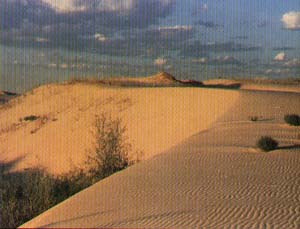Flora/Fauna:
The park is only a small portion of a dune field that extends about 200 miles from
south of
Monahans westward and north into New Mexico. Most of these dunes are stabilized by
vegetation, but the park is one area where many dunes are still active. Active dunes
grow andchange shape in response to seasonal, prevailing winds, so the visitor may
experience a dynamic landscape.
Fresh water occurs at shallow depths within the dunefield and sometimes stands in
shallow ponds in low areas between dunes. A quiet vigil near such ponds at dusk or
dawn is the best way to observe wildlife. Shinoak (Quercus havardii), one of the plants which
stabilize the dunes, is not a stunted or dwarfed form of a larger tree but a fully mature plant
which bears an abundance of large acorns and usually stands less than four feet tall.
Directions:
To reach the park, travel Interstate 20 and Exit Mile Marker #86 to Park Road 41.
Elevation, Weather, and Schedule Information:
Elevation: 2,724.67. Weather: Average January minimum 29;
average July maximum 96; average annual rainfall 12.3. Open: 7 days a week year-round.
Busy Season: March through August.
Area Attractions:
Points of interest nearby include Balmorhea State Park; Million Barrel Museum in
Monahans; the Odessa Meteor Crater, a national, natural landmark; and the Cities of Midland and Odessa.
Camping fees vary; entrance fee. For reservations, call 512/389-8900. For more
details, call the park or Park Information at 1-800-792-1112.
For more information visit the links below:
Monahans State Park





